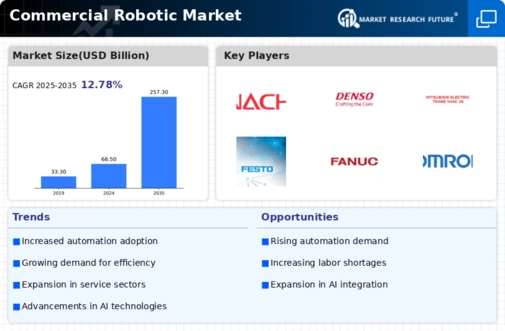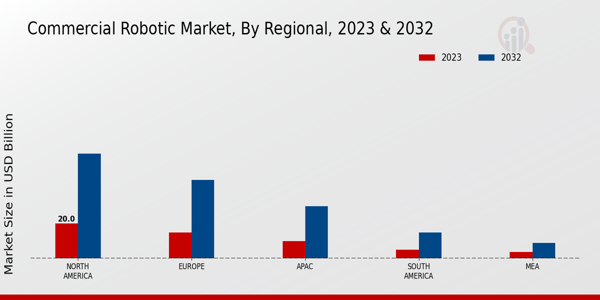Labor Shortages
The Global Commercial Robotic Market Industry is significantly influenced by labor shortages in various industries. As the workforce ages and fewer individuals enter skilled labor roles, companies are turning to robotics to fill the gaps. For instance, in sectors like agriculture and manufacturing, robots are being deployed to perform tasks that are difficult to staff. This shift not only addresses labor shortages but also enhances productivity and operational efficiency. The market is expected to grow at a CAGR of 12.78% from 2025 to 2035, reflecting the increasing reliance on robotic solutions to mitigate workforce challenges.
Market Growth Projections
The Global Commercial Robotic Market Industry is projected to experience substantial growth in the coming years. With a market value anticipated to reach 68.5 USD Billion in 2024 and further expand to 257.3 USD Billion by 2035, the industry is on a robust upward trajectory. The compound annual growth rate (CAGR) of 12.78% from 2025 to 2035 indicates a strong and sustained demand for commercial robotic solutions. This growth is likely driven by various factors, including technological advancements, increased automation, and the need for efficient supply chain management.
Technological Advancements
The Global Commercial Robotic Market Industry is experiencing rapid growth driven by technological advancements in robotics and automation. Innovations in artificial intelligence, machine learning, and sensor technologies are enhancing the capabilities of commercial robots. For instance, robots are now capable of performing complex tasks such as autonomous navigation and real-time data analysis. These advancements not only improve efficiency but also reduce operational costs for businesses. As a result, the market is projected to reach 68.5 USD Billion in 2024, reflecting a strong demand for sophisticated robotic solutions across various sectors.
Rising Investment in Robotics
The Global Commercial Robotic Market Industry is bolstered by rising investments in robotics technology from both private and public sectors. Governments are recognizing the potential of robotics to drive economic growth and are funding research and development initiatives. For example, initiatives aimed at fostering innovation in robotic technologies are being launched in various countries. This influx of capital is likely to accelerate advancements in commercial robotics, leading to more sophisticated and versatile solutions. As investments continue to rise, the market is poised for substantial growth, further solidifying its position in the global economy.
Increased Demand for Automation
The Global Commercial Robotic Market Industry is witnessing a surge in demand for automation across multiple sectors, including manufacturing, logistics, and healthcare. Businesses are increasingly adopting robotic solutions to streamline operations, enhance productivity, and reduce labor costs. For example, automated guided vehicles are becoming commonplace in warehouses, facilitating efficient inventory management. This trend is expected to contribute to the market's growth, with projections indicating a rise to 257.3 USD Billion by 2035. The increasing need for operational efficiency and cost-effectiveness is likely to drive further investments in commercial robotics.
Global Supply Chain Optimization
The Global Commercial Robotic Market Industry is increasingly shaped by the need for global supply chain optimization. Companies are adopting robotic solutions to enhance logistics and distribution processes, ensuring timely delivery and reduced operational costs. For instance, robotic arms are utilized in packaging and sorting, improving efficiency in supply chain operations. This trend is particularly relevant in the context of e-commerce, where rapid fulfillment is essential. As businesses strive for greater efficiency and responsiveness in their supply chains, the demand for commercial robotics is expected to grow, contributing to the overall market expansion.













